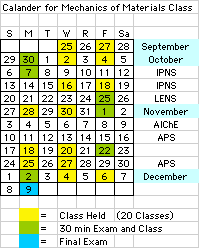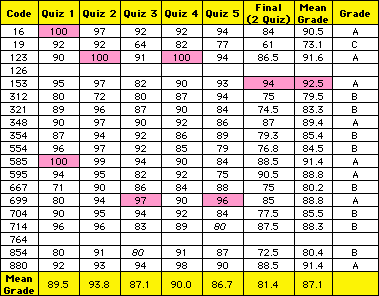Mechanics of Materials
=> To Current Grades
Evaluations Fall 2002
Quizes: Quiz 1, Quiz 2, Quiz 3, Quiz 4,
Quiz 5,
Final
Homework: Quiz1Homework
Course Synopsis:
The course will provide tools to understand the mechanical behavior of polymers, ceramics and metals. The course centers on an expansion of the discussion of continuum mechanics and constitutive equations begun in the introductory mechanics course. Mechanics of Materials focuses on a tensoral description of stress strain and strain rate. The course will consider both dynamic and static behavior and will consider the coupling of these in viscoelastic materials.
Books:
Although there is no assigned text for the course, it is highly suggested that the students purchase a text that outlines the application of continuum mechanics to either polymers, ceramics or metals. The course web notes will follow books listed below.
- Web notes
-
Understanding Rheology, F. A. Morrison
-
The Physics of Polymers, G. Strobl
-
Introduction to Continuum Mechanics, L. E. Malvern
-
Viscoelastic Properties of Polymers, J. D. Ferry
-
A First Course in Continuum Mechanics, Y. C. Fung
-
Fracture Mechanics of Polymers, J. G. Williams
-
Mechanical Properties of Solid Polymers, I. M. Ward
-
Dynamics of Polymer Liquids (Vol 1), Bird, Armstrong, Hassager
-
Mechanical Metallurgy, G. E. Dieter
-
The Structure of Materials, Samuel Allen, Edwin Thomas (Ned), This is an important book that partly unifies structre and properties of different materials. You should read it!
The last book was previously used as a text for this course.
Outline of Course: (Links are to pdf web notes)
- Stress, Strain, Rate of Strain.
Tensoral description of mechanical deformation.
Basic Constitutive Relationships.
Viscosity, modulus, compliance
Creep and Stress Relaxation -
Rubber Elasticity
Theory of polymeric mechanical response. -
Continuum Mechanics and Fluid Flow
Coupling of viscosity, compliance and relaxation
-
Dynamic Mechanical Behavior (complex description of simple behavior)
DMA Intro Link
Link to DMA 1
Link to DMA 2
Link to DMA 3
Link to DMA 4
Modes of Relaxation
Specific Relaxations -
Terminal Mechanical Properties: Ductile and Brittle Behavior
Chapter 5.pdf
Von Mises, Tresca, Griffith and modern modifications -
Morphological Basis for Mechanical Response in Metals and Ceramics
Crystallographic deformation, deformation of grains, Chapter 6. pdf -
Parallel models in semi-crystalline polymers,
Polymer Yielding
Chapter 7 From Characterization Class.pdf
Chapter 7 From Morphology Class.pdf -
Multi-Phase Systems
Elastomers, Chapter 8.pdf
Grades:
The course grade will be an average of 30 minute exams every third meeting of the class and a one hour comprehensive final exam with the weight of two short exams.
These exams will focus on concepts and application rather than problem solving.
Grading will strictly follow 100-90.0 A, 89.9-80.0 B, 79.9-70.0 C.
Prof. Greg Beaucage
540 ERC/410 Rhodes
6-3063, 6-5152
beaucag@uc.edu
Class Schedule:

Current Grades:

Grading will strictly follow 100-90.0 A, 89.9-80.0 B, 79.9-70.0 C.
*Problem: Course evaluations were taken but were lost by the
college.Copyright (c) 2002

BeaucageResearchGroup page, designed by / G. Beaucage / beaucag@uc.edu